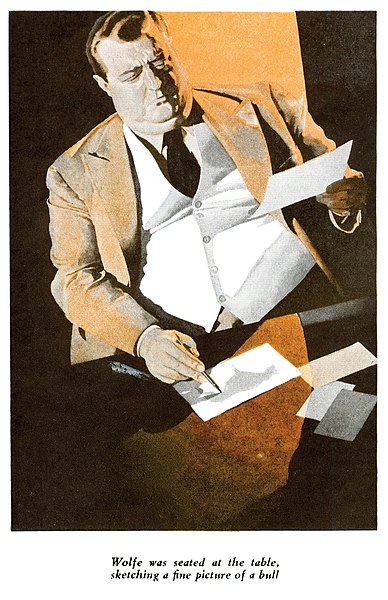Fer-de-Lance is the first Nero Wolfe detective novel written by Rex Stout, published in 1934 by Farrar & Rinehart, Inc. The novel appeared in abridged form in The American Magazine under the title "Point of Death". The novel was adapted for the 1936 film Meet Nero Wolfe, and it was named after a venomous snake with the same name. In his seminal 1941 work, Murder for Pleasure, crime fiction historian Howard Haycraft included Fer-de-Lance in his definitive list of the most influential works of mystery fiction.
Fer-de-Lance (novel)
Illustrator Fred Ludekens created the first visual interpretation of Nero Wolfe and Archie Goodwin for the abridged version of Fer-de-Lance that appeared in The American Magazine (November 1934)
Legendary book designer George Salter produced hundreds of covers for the digest format paperbacks published by Lawrence E. Spivak's The American Mercury. One of the earliest is an abridged version of Fer-de-Lance titled Meet Nero Wolfe (A Mercury Book No. 37, undated), which utilizes the title of the 1936 Columbia Pictures adaptation of the novel.
Image: Wolfe Fer de Lance ad
Nero Wolfe is a brilliant, obese and eccentric fictional armchair detective created in 1934 by American mystery writer Rex Stout. Wolfe was born in Montenegro and keeps his past murky. He lives in a luxurious brownstone on West 35th Street in New York City, and he is loath to leave his home for business or anything that would keep him from reading his books, tending his orchids, or eating the gourmet meals prepared by his chef, Fritz Brenner. Archie Goodwin, Wolfe's sharp-witted, dapper young confidential assistant with an eye for attractive women, narrates the cases and does the legwork for the detective genius.
Carl Mueller illustrated "The Red Bull" (1938) for The American Magazine
Nero Wolfe and his boyhood friend Marko Vukcic hunted dragonflies in the mountains where Wolfe was born, in the vicinity of Lovćen
Manhattan brownstone used for exteriors in A&E TV's Nero Wolfe
Cartoon by Stan Hunt for The American Magazine (June 1949)








